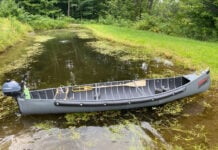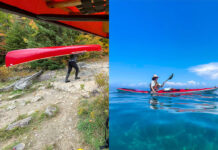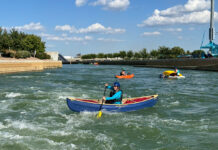Full disclosure: aside from whitewater open boating, I’ve never paddled a true solo canoe. A built-for-one, single-seat lakewater cruising canoe has simply not been within my reach.
Swift’s Cruiser 16.8 Solo Canoe Specs
Length: 16 ft 8 in
Width: 29.5 in
Weight: 29 Pounds
Material: Carbon Fusion
MSRP: $4,595 CAD/$4,195 USD
Blame my ingrained frugality on a lifetime of prioritizing freedom over paychecks. I’ve grown accustomed to compromise, a diehard acolyte of the one-canoe-to-do-it-all ethos.
If you’re like me, you probably have one of these in your backyard: 16 feet long, medium-weight layup, designed for two but manageable—most of the time—for one.
Recently, however, I had a revelation. Earlier this spring, I was invited by the composite wizards at Swift Canoe & Kayak to paddle their new, race-inspired solo tripping canoe.
The Cruiser 16.8 is the antithesis of my utilitarian, do-almost-everything canoe. It is sleek. It is specific. It looks like a cruise missile-shaped from yards of shimmering carbon fiber.
Credit for the Cruiser 16.8’s sophisticated lines goes to David Yost, one of the most prolific small boat designers of all time. With something like 200 canoe, pack boat and kayak designs to his credit, Yost has a particular flair for crafting solo canoes.
In the 1960s, Yost was competing in marathon canoe racing. To save a few bucks—a kindred spirit!—he began building his own solo boats to race. Soon, he was designing racing canoes for friends. A solo tripper followed, the first of many Yost designs as adept at hauling gear as they were keeping pace with tandem paddlers.
Yost’s latest design honors those roots—fast, seaworthy and privileging the solo paddler—while incorporating more than four decades of design experience and material innovations. Swift Canoe & Kayak owner Bill Swift says the genesis for the Cruiser’s shape started with one of Yost’s earlier marathon racing canoes, the Sawyer Shockwave. Then, he says, “We gave the Cruiser more rocker and volume, and we carried that volume up further so it would be more stable and controllable in wind and waves.”
Crafted in Swift’s Ultralight Carbon Fusion layup, my sapphire-blue-and-black Cruiser 16.8 feels even lighter than its listed 29 pounds.
Fusion refers to the layers of carbon, Kevlar and Innegra cloth fused around a foam core and ribs with high-impact epoxy vinylester resin. Gelcoat on the hull below the waterline adds a splash of color and an extra layer of abrasion resistance.
Paddling stern first in my trusty tandem, I consider myself a competent solo tripper, shifting packs and barrels to trim the canoe, a cherry ottertail and relaxed J-stroke propelling me lazily across the lakes. The Cruiser 16.8 is outfitted with a sliding tractor seat and carbon foot bar, suggesting a very different style.
“This is a fantastic tripping canoe for someone using a bent shaft paddle who wants to travel quickly and efficiently,” confirms Swift.
Armed with a borrowed bent shaft to match my borrowed boat, the urgent rhythm of the sit-and-switch paddler—stroke-stroke-stroke-switch!-stroke-stroke-stroke-switch!—feels awkward and slow to me. The bow veers drunkenly between the banks of my local river, swollen with the spring freshet. My top hand fumbles the paddle grip when I swing the blade across the bow, an indignity every bit as mortifying as a missed high five.
After a couple hours, trapezii muscles burning, I am beginning to find my tempo.
The Cruiser 16.8 is a forgiving first solo canoe, deftly bridging the realms of recreational racing and lakewater cruising.
The nearly flat hull curves into generously rounded chines so the boat feels stable in spite of its slim width, even in bumpy conditions. An inch of bow rocker and half that in the stern make for a design which prioritizes tracking and speed over agility, but heeled over the Cruiser carves graceful edged turns.
Acceleration is a delight; a couple strokes on each side and the eponymous Cruiser is swiftly up to speed. The greatest pleasure of Swift’s new solo boat may be that it maintains the glide of a fast 17-footer, while scaling width and depth to perfectly suit the lone paddler.
Also check out the Swift Cruiser 14.8 in the video below.
Bill Swift describes the Cruiser as having “a very narrow paddling station” for maximum efficiency.
“You can keep your stroke right next to your body,” he says. Yost achieved this by combining ample tumblehome with recurved gunwales tapering together near the paddler’s feet and flaring back out behind the seat. My bottom hand slips neatly along the pocket of hull created by the tumblehome, seemingly close enough to catch a stray thumb in my belt loop. Swift Canoe’s mastery of composite trim makes such radical shaping possible. “It would be difficult to get wood or aluminum to bend like this,” adds Swift.
Further efficiency is provided by the carbon foot brace, which allows effective power transfer and stability when seated. Outfitting adjustments are straightforward: the foot brace uses two quick release pins; the carbon seat can be moved on-the-fly by simply unweighting it and sliding. Trimming the seat fore or aft accommodates a wide range of paddler sizes and variable conditions and gear loads.
Those keen to explore the Cruiser 16.8’s tripping potential will find there’s plenty of room for packs or barrels in the spacious stern and long, narrow bow.
Together, the hull speed and storage capacity also make this an exciting new option for soloists competing in endurance races like the Yukon River Quest or Missouri River 340.
Turning toward home after a lengthy and tiring upstream tour, I experience an illusion of radically improved technique as the Cruiser 16.8 accelerates with the assistance of the river current. I slip effortlessly past the backyards of cottage country, waving victoriously at weekenders toiling in their gardens or lounging on their decks. For a few giddy moments, I imagine I am gliding across some far-flung finish line.
A man raking leaves pauses from his work to gaze appreciatively at my speedy passage. “You’re the first boat I’ve seen this season,” he calls to me, raising his index finger emphatically. “You’re number one.”










I remember back in 2004 when I bought a beautiful new Hemlock Peregrine kevlar/carbon canoe for a bit north of $2k. That same canoe now costs around $3,600, and this Swift model is north of $4k USD. The prices of higher end canoes have become out of reach for many potential buyers.